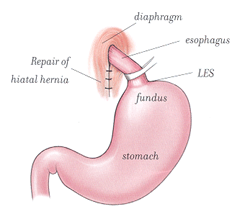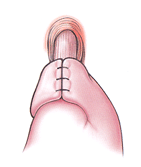Acid Reflux:
- Why we get acid reflux
- Symptoms
- Complications of acid reflux
- Diagnosis
- Non-surgical treatments
- Surgery
- Life after surgery
Surgery for acid reflux comprises three aims:
- Increase of intra-abdominal oesophageal length
- Reconstruction of diaphragmatic hiatus
- Strengthening of lower oesophageal sphincter
Laparoscopic surgery has made the surgical treatment of this condition much more attractive to patients.
Open surgery is associated with a large wound and a long recovery period, which laparoscopic fundoplication avoids.
 The operation involves the mobilisation of the abdominal portion of the oesophagus. This helps to reduce reflux by allowing the abdominal pressure to help compress the oesophagus.
The operation involves the mobilisation of the abdominal portion of the oesophagus. This helps to reduce reflux by allowing the abdominal pressure to help compress the oesophagus.
Often there is a hiatus hernia present and reconstruction of the muscles of the diaphragm where the oesophagus passes through is necessary. This is performed to help the diaphragm to "pinch" the lower oesophagus when it contracts.
The intrinsic weakness of the lower oesophageal sphincter is addressed by the formation of a fundic wrap. This wrap augments the effects of the sphincter in preventing reflux. The pressure within the stomach is transmitted to the lower oesophagus which is compressed by this action.
 Several techniques of fundic wrap exist, anterior, posterior and encircling (360 degree).
Several techniques of fundic wrap exist, anterior, posterior and encircling (360 degree).
Often the best approach depends upon the experience and skill of the surgeon as well as taking into account results from the investigations performed:
A balance being struck between reflux and the reduced ability for the patient to swallow comfortably (dysphagia).
The "tailored" approach to the fundoplication is the technique which is currently most favoured.